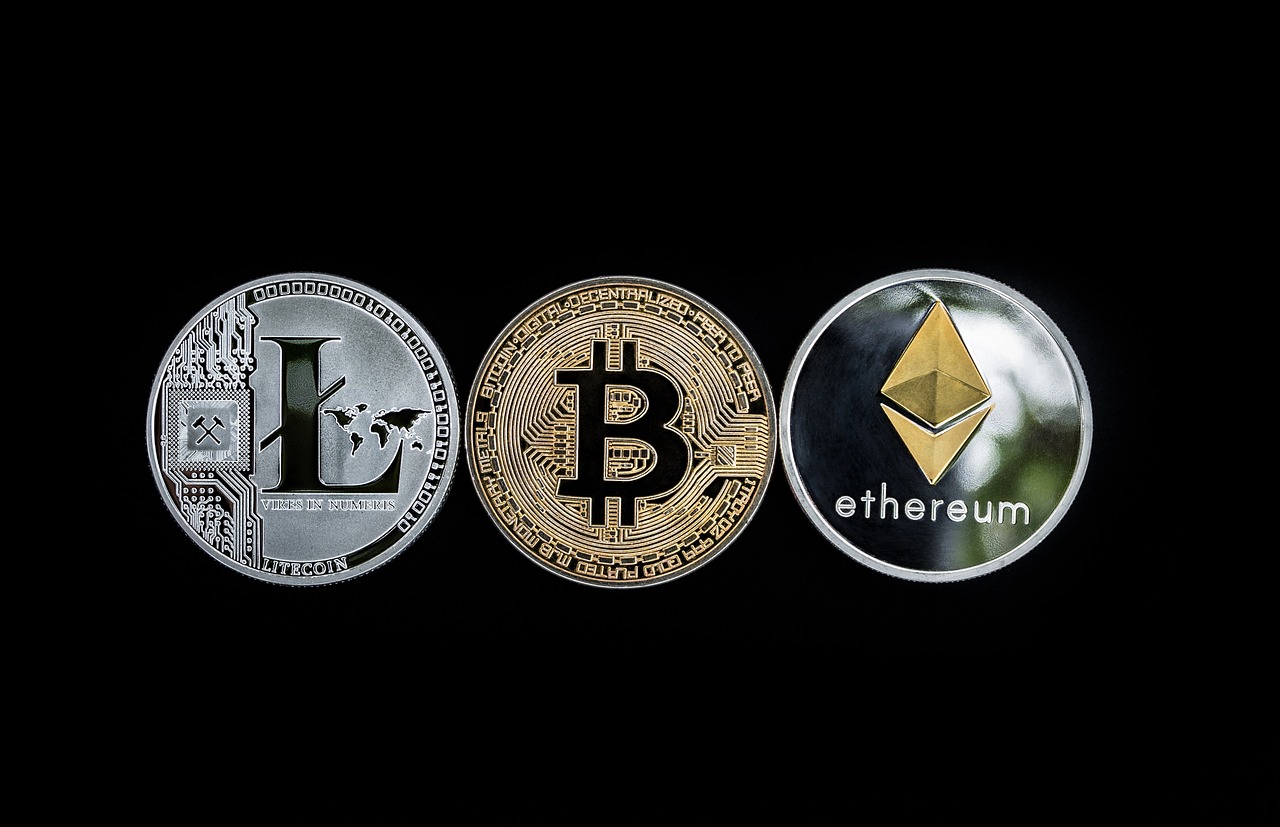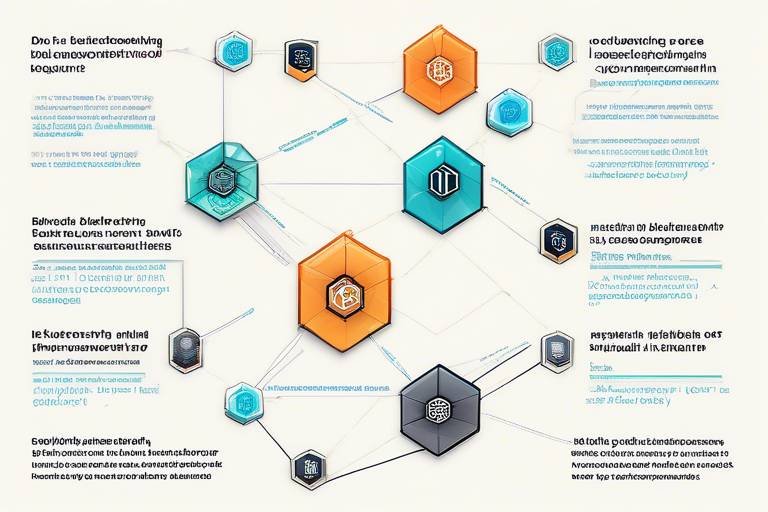Understanding Blockchain's Role in Fighting Climate Change
Climate change is one of the most pressing challenges of our time, threatening our planet and future generations. As we grapple with rising temperatures and extreme weather events, innovative solutions are essential. Enter blockchain technology—a game-changer that can help combat climate change in ways we might not have imagined. But how exactly can a decentralized digital ledger contribute to this global crisis? Let’s dive into the fascinating world of blockchain and explore its potential to enhance transparency, improve efficiency, and drive innovative solutions across various sectors.
At its core, blockchain is a decentralized ledger that records transactions across many computers so that the registered transactions cannot be altered retroactively. This technology not only ensures security and authenticity but also promotes trust among users. Imagine a world where every carbon credit is tracked and verified in real-time, eliminating fraud and increasing accountability. This is just the tip of the iceberg when it comes to the transformative potential of blockchain in the fight against climate change.
As we explore the various applications of blockchain technology, it becomes clear that its impact can be profound. For instance, in carbon markets, blockchain can enhance transparency, ensuring that every transaction is traceable and verifiable. This leads to more effective climate change mitigation efforts, as stakeholders can trust the integrity of the system. Furthermore, by utilizing smart contracts, we can automate processes, reducing the administrative burdens that often slow down initiatives aimed at reducing carbon emissions.
Another exciting avenue is the development of decentralized platforms for trading carbon credits. These platforms can democratize access to carbon markets, allowing smaller players to participate and ensuring fairer pricing. In the realm of supply chain management, blockchain can provide the transparency needed to track emissions and sustainability practices throughout an organization’s operations. The potential applications of blockchain in renewable energy are equally promising, from revolutionizing renewable energy certificate trading to facilitating decentralized energy grids.
However, as with any technology, there are challenges to consider. The energy consumption of blockchain itself, particularly with energy-intensive consensus mechanisms like proof-of-work, raises valid concerns about its environmental footprint. Additionally, navigating the regulatory landscape surrounding blockchain and climate initiatives can be daunting, with potential barriers that need to be addressed for innovation to flourish.
Looking ahead, the future prospects of blockchain in the fight against climate change are bright. With collaborative efforts across sectors, we can maximize the impact of this technology. As we continue to innovate and adapt, blockchain stands ready to play a pivotal role in our collective efforts to create a more sustainable future. The intersection of technology and environmental responsibility is not just a possibility; it’s an imperative.
- What is blockchain technology? - Blockchain is a decentralized digital ledger that records transactions across multiple computers, ensuring security and transparency.
- How does blockchain help combat climate change? - It enhances transparency in carbon markets, automates processes through smart contracts, and improves supply chain management.
- What are the challenges of using blockchain for climate initiatives? - Challenges include energy consumption, scalability issues, and regulatory hurdles that need to be navigated.
- What is a smart contract? - A smart contract is a self-executing contract with the terms of the agreement directly written into code, allowing for automated transactions.
- Can blockchain make carbon trading more accessible? - Yes, decentralized platforms can democratize access to carbon markets, allowing more participants and fairer pricing.

Blockchain Basics
Blockchain technology is often described as a digital ledger that operates on a decentralized network. But what does that really mean? At its core, blockchain is a series of blocks, each containing data, that are linked together in a chain. This structure not only ensures that the information is secure but also makes it nearly impossible to alter once it's been added. Imagine a public library where every book represents a block; once a book is placed on the shelf, it can’t be removed or changed without everyone knowing. This transparency is one of the key features that makes blockchain so revolutionary, especially in the context of climate action.
The fundamental principles of blockchain include decentralization, transparency, and security. Unlike traditional databases controlled by a single entity, a blockchain is managed by a network of computers (or nodes) that validate and record transactions. This decentralization not only enhances security but also fosters trust among participants, as everyone has access to the same information. For instance, if a company claims to have offset a certain amount of carbon emissions, anyone can verify that claim by checking the blockchain. This level of transparency is crucial for combating climate change, as it helps hold businesses accountable for their environmental impact.
So, how does blockchain actually work? When a transaction occurs, it is grouped with other transactions into a block. This block is then added to the existing chain of blocks in a linear, chronological order. Each block contains a unique code called a hash, which is generated from the block's data. If someone tries to tamper with the information in a block, the hash would change, alerting the network to the discrepancy. This mechanism is akin to a digital fingerprint—unique to each block—and ensures the integrity of the entire blockchain.
Additionally, blockchain operates using various consensus mechanisms to validate transactions. The most common is proof-of-work, where nodes compete to solve complex mathematical problems to add a new block to the chain. However, this method can be energy-intensive, raising questions about its sustainability. Other consensus mechanisms, like proof-of-stake, are being explored as more eco-friendly alternatives. As we delve deeper into how blockchain can aid in fighting climate change, understanding these basic principles will provide a solid foundation for grasping its potential applications.
In summary, blockchain is not just a buzzword; it's a transformative technology that holds significant promise for enhancing transparency and accountability in various sectors, particularly in the fight against climate change. As we continue to explore its applications, it's essential to recognize how this innovative technology can pave the way for a more sustainable future.

Transparency in Carbon Markets
When it comes to tackling climate change, one of the biggest hurdles we face is ensuring transparency in carbon markets. It's like trying to navigate a foggy road without a GPS—hard to see where you're going, and even harder to trust the directions. This is where blockchain technology steps in, shining a light on the murky waters of carbon credit trading. By providing a decentralized and immutable ledger, blockchain can significantly enhance the authenticity and traceability of carbon credits, making it easier for stakeholders to trust the system.
Imagine a world where every carbon credit is tracked from its origin to its final sale. With blockchain, each transaction is recorded in a way that is both visible and verifiable. This means that if a company claims to have offset a certain amount of carbon, there’s a transparent record to back it up. No more guessing games or shady practices; just clear, trustworthy data. This level of transparency can lead to more effective climate change mitigation efforts, as stakeholders can make informed decisions based on reliable information.
But how does this work in practice? Let’s break it down a bit further:
- Verification of Carbon Credits: Blockchain can streamline the process of verifying carbon credits, ensuring they are legitimate and not double-counted. This reduces fraud and increases trust among stakeholders, which is vital for the credibility of carbon markets.
- Smart Contracts for Automation: Smart contracts can automate the buying and selling of carbon credits, making transactions faster and reducing administrative burdens. Imagine setting up a contract that executes automatically when certain conditions are met—talk about efficiency!
- Decentralized Platforms for Trading: With blockchain, decentralized platforms are emerging that allow for trading carbon credits without the need for intermediaries. This promotes fairer pricing and accessibility, especially for smaller players who may have been sidelined in traditional markets.
In essence, the integration of blockchain into carbon markets is like adding a security camera to a busy intersection. It not only keeps everyone accountable but also fosters a sense of community among participants. By enhancing transparency, we can encourage more companies and individuals to engage in carbon trading, ultimately driving more robust climate action.
However, while the potential benefits are significant, it’s essential to recognize that implementing blockchain in carbon markets is not without its challenges. Issues such as the energy consumption of blockchain technology and regulatory hurdles need to be addressed to fully realize its potential. But with the right strategies in place, the future of carbon markets could be much brighter, paving the way for a more sustainable world.
- What is a carbon credit? A carbon credit is a permit that allows the holder to emit a certain amount of carbon dioxide or other greenhouse gases. One credit typically represents one ton of emissions.
- How does blockchain improve transparency? Blockchain provides a decentralized and immutable record of transactions, making it easier to verify the authenticity and traceability of carbon credits.
- What are smart contracts? Smart contracts are self-executing contracts with the terms of the agreement directly written into code. They automate processes and reduce the need for intermediaries.
- What are decentralized platforms? These are platforms that operate without a central authority, allowing users to trade carbon credits directly with one another, promoting fairer pricing and accessibility.

Verification of Carbon Credits
The verification of carbon credits is a critical aspect of ensuring that climate action initiatives are both effective and trustworthy. In a world where every ton of carbon dioxide saved counts, the integrity of carbon credits becomes paramount. Blockchain technology steps in as a game-changer by providing a transparent and immutable record of carbon credit transactions. This transparency not only enhances credibility but also significantly reduces the risk of fraud. Imagine a world where every carbon credit can be traced back to its source, where stakeholders can verify that the credits they purchase genuinely represent a reduction in emissions. This is the promise that blockchain holds.
With traditional systems, verifying carbon credits often involves cumbersome processes that can be easily manipulated. However, with blockchain, each carbon credit is assigned a unique digital signature, recorded on a decentralized ledger that is accessible to all participants. This means that once a carbon credit is issued, it cannot be altered or duplicated. The result? A significant increase in trust among buyers, sellers, and regulatory bodies alike. The potential for increased investment in carbon markets is substantial, as investors can feel confident that their contributions are making a real difference.
Moreover, the use of smart contracts on blockchain platforms can automate the verification process. When specific criteria are met—such as a verified reduction in emissions or successful completion of a sustainability project—smart contracts can automatically issue carbon credits. This automation not only streamlines the process but also minimizes human error, further enhancing the reliability of the carbon credit system. In essence, blockchain transforms the verification of carbon credits from a complex, often opaque process into a straightforward, transparent, and efficient one.
In addition to enhancing trust and efficiency, blockchain can also facilitate the creation of a global registry for carbon credits. This registry can serve as a centralized hub where all carbon credits are logged, providing a comprehensive overview of the market. Stakeholders can easily access data regarding the origin, status, and ownership of carbon credits, fostering a more informed trading environment. The implications of such a system are profound, as it can lead to better-informed decisions by businesses, governments, and individuals looking to invest in carbon credits.
In summary, the verification of carbon credits through blockchain technology not only addresses the challenges of fraud and inefficiency but also builds a foundation of trust that is essential for the growth of carbon markets. With a transparent, automated, and globally accessible system in place, we can expect to see a surge in participation and investment in climate action initiatives, ultimately contributing to the fight against climate change.
- What are carbon credits? Carbon credits are permits that allow the holder to emit a certain amount of carbon dioxide or other greenhouse gases. One credit typically represents one ton of emissions.
- How does blockchain improve carbon credit verification? Blockchain provides a transparent and immutable record of transactions, ensuring that each carbon credit can be traced back to its origin, thus reducing fraud.
- What is a smart contract? A smart contract is a self-executing contract with the terms of the agreement directly written into code, allowing for automatic verification and issuance of carbon credits.
- Can blockchain help in other areas of climate action? Absolutely! Blockchain can enhance transparency and efficiency in various sectors, including renewable energy, supply chain management, and sustainable practices.

Smart Contracts for Automation
When we think about the future of technology and its intersection with environmental sustainability, smart contracts on the blockchain emerge as a game-changer. Imagine a world where agreements are not just signed but automatically executed without the need for intermediaries. This is precisely what smart contracts offer, and their potential in automating processes within carbon markets is nothing short of revolutionary.
At their core, smart contracts are self-executing contracts with the terms of the agreement directly written into code. They operate on a decentralized network, which means that once they are deployed, they function independently of human intervention. This automation can significantly streamline the transactions involved in carbon credit trading. For instance, when a company purchases carbon credits, a smart contract can automatically verify the transaction, ensure compliance with regulations, and update the relevant parties in real-time. This not only reduces the risk of fraud but also enhances the overall efficiency of the trading process.
Furthermore, the use of smart contracts can lead to substantial cost savings. By eliminating the need for intermediaries—such as brokers and auditors—companies can redirect their resources toward more impactful climate initiatives. Think of it like cutting out the middleman when buying groceries; you save money and time, allowing you to focus on what really matters—like reducing your carbon footprint.
Additionally, smart contracts can be programmed to trigger specific actions based on predetermined conditions. For example, if a company successfully reduces its emissions by a certain percentage, a smart contract could automatically release additional carbon credits as a reward. This kind of incentive mechanism encourages companies to adopt greener practices, fostering a culture of sustainability.
However, it's essential to recognize that while smart contracts offer numerous benefits, they are not without challenges. Issues such as code vulnerabilities and the need for robust regulatory frameworks must be addressed to ensure their safe and effective implementation. As we move forward, collaboration between technology developers, environmentalists, and policymakers will be crucial in navigating these hurdles.
In conclusion, smart contracts hold immense potential to automate and enhance the efficiency of carbon markets. By leveraging this technology, we can create a more transparent, trustworthy, and efficient system for trading carbon credits, ultimately contributing to our fight against climate change.
- What are smart contracts? Smart contracts are self-executing contracts with the terms of the agreement directly written into code, allowing for automated execution without intermediaries.
- How do smart contracts improve carbon credit trading? They streamline transactions, enhance transparency, reduce fraud, and create incentive mechanisms for sustainable practices.
- What are the challenges associated with smart contracts? Challenges include code vulnerabilities, the need for regulatory frameworks, and potential scalability issues.
- Can smart contracts be used in other areas besides carbon markets? Absolutely! Smart contracts can be applied in various sectors, including supply chain management, real estate, and financial services.

Decentralized Platforms for Trading
Decentralized platforms for trading carbon credits are emerging as a game changer in the fight against climate change. Imagine a marketplace where buyers and sellers can interact directly without the need for intermediaries. This is the essence of decentralized trading platforms, which leverage blockchain technology to create a more equitable and transparent market for carbon credits. By removing the middlemen, these platforms not only reduce transaction costs but also empower smaller players who might have been previously sidelined in traditional carbon markets.
One of the most significant benefits of decentralized trading is the enhanced transparency it offers. Each transaction is recorded on the blockchain, providing a public ledger that anyone can access. This means that all trades are verifiable, helping to prevent fraudulent activities that have plagued carbon markets in the past. Buyers can trace the origins of their carbon credits, ensuring that they are purchasing legitimate offsets that contribute to actual environmental benefits. This level of transparency builds trust among participants, which is crucial for the success of any market.
Moreover, decentralized platforms can facilitate a more dynamic pricing mechanism. Traditional markets often suffer from price manipulation and lack of competition, which can lead to inflated prices for carbon credits. With a decentralized approach, prices are determined by supply and demand in real-time, allowing for fairer pricing that reflects the true value of carbon offsets. This not only benefits buyers but also incentivizes sellers to improve their sustainability practices to attract more customers.
Another exciting aspect of these platforms is their ability to integrate with various sustainability initiatives. For instance, they can connect with renewable energy projects, allowing energy producers to sell carbon credits directly related to their green energy outputs. This creates a more holistic approach to climate action, where different sectors can collaborate and contribute to a unified goal of reducing emissions.
However, while the potential of decentralized trading platforms is immense, they are not without challenges. Issues such as regulatory compliance and user adoption need to be addressed to ensure these platforms can operate effectively and securely. As the technology matures, we can expect to see more innovative solutions that will enhance the functionality and accessibility of decentralized trading for carbon credits.
In conclusion, decentralized platforms for trading carbon credits represent a promising frontier in the quest for climate action. By harnessing the power of blockchain, these platforms can create a more transparent, efficient, and equitable marketplace that benefits all stakeholders involved. With ongoing advancements and increased collaboration across sectors, the future of carbon trading looks brighter than ever.
- What are decentralized platforms for trading? Decentralized platforms for trading allow buyers and sellers to interact directly without intermediaries, leveraging blockchain technology for transparency and efficiency.
- How do these platforms enhance transparency? Transactions are recorded on a public ledger, ensuring that all trades are verifiable and helping to prevent fraud.
- What are the benefits of decentralized trading? Benefits include reduced transaction costs, fairer pricing mechanisms, and the ability to connect with sustainability initiatives.
- What challenges do decentralized platforms face? Challenges include regulatory compliance and user adoption, which need to be addressed for effective operation.

Supply Chain Management
In today's fast-paced world, where sustainability is becoming a non-negotiable demand from consumers and regulators alike, blockchain technology is emerging as a game-changer in supply chain management. Imagine a scenario where every step of a product's journey—from raw materials to the final consumer—is transparently recorded on a tamper-proof digital ledger. This is precisely what blockchain offers: a decentralized and immutable record that enhances accountability and traceability throughout the supply chain.
One of the most significant advantages of blockchain in supply chain management is its ability to provide real-time visibility. Companies can track emissions and sustainability practices at every stage of the supply chain, ensuring that they adhere to environmental standards. This level of transparency not only helps in identifying inefficiencies but also fosters trust among stakeholders, from manufacturers to consumers. When customers know the origin of their products and the environmental impact associated with them, it significantly influences their purchasing decisions.
Furthermore, blockchain can streamline the verification process of sustainability claims. For instance, let’s say a company claims that its product is made from recycled materials. With blockchain, this assertion can be verified through a series of digital records that trace the material's journey. This verification process reduces the risk of greenwashing, where companies exaggerate or falsely claim their environmental efforts. Instead, stakeholders can rely on a system that provides factual data, enhancing credibility and fostering a culture of accountability.
Additionally, the integration of blockchain with the Internet of Things (IoT) can revolutionize supply chain management. Sensors can collect data on various parameters such as temperature, humidity, and location, which can be recorded on the blockchain. This not only helps in maintaining product quality but also in tracking emissions associated with transportation and storage. Imagine a scenario where a shipment of organic produce is monitored in real-time, ensuring it remains within optimal conditions, and all data is stored on an immutable ledger. This not only enhances quality control but also provides valuable insights for improving sustainability practices.
However, while the potential of blockchain in supply chain management is immense, it is crucial to address the challenges that come with its implementation. Issues such as interoperability between different blockchain platforms, the need for industry standards, and the initial costs of adopting this technology can pose significant hurdles. Companies must navigate these challenges to fully leverage the benefits of blockchain and ensure that it contributes positively to their sustainability goals.
In summary, blockchain technology holds the key to transforming supply chain management by enhancing transparency, accountability, and efficiency. By providing a clear picture of the environmental impact of products, it empowers consumers to make informed decisions and encourages companies to adopt more sustainable practices. As we continue to face the pressing challenge of climate change, the role of blockchain in supply chain management will undoubtedly become more critical.
- How does blockchain improve supply chain transparency?
Blockchain provides a decentralized ledger that records every transaction in a tamper-proof manner, allowing all stakeholders to access real-time data about product origins and environmental impacts. - Can blockchain help reduce greenwashing?
Yes, by enabling verification of sustainability claims through immutable records, blockchain reduces the risk of companies making false or exaggerated environmental claims. - What are the challenges of implementing blockchain in supply chains?
Challenges include interoperability between different blockchain platforms, the need for industry standards, and initial implementation costs.

Renewable Energy Certificates
In the quest for a sustainable future, Renewable Energy Certificates (RECs) have emerged as a pivotal tool in promoting the use of clean energy sources. Essentially, a REC represents the environmental benefits of generating one megawatt-hour (MWh) of electricity from renewable sources like wind, solar, or hydro. But how does blockchain fit into this picture? Well, by leveraging blockchain technology, we can significantly enhance the efficiency and trustworthiness of REC trading.
Imagine a world where every time you flip a switch, you can trace the source of your electricity back to its origins. With blockchain, this is not just a dream but a feasible reality. By utilizing a decentralized ledger, all transactions related to RECs can be recorded transparently, ensuring that each certificate is unique and cannot be duplicated. This level of transparency is crucial in a market that often grapples with fraud and misrepresentation.
Moreover, blockchain can automate the process of issuing and trading RECs through the use of smart contracts. These self-executing contracts can facilitate transactions without the need for intermediaries, thus reducing costs and administrative burdens. For instance, when a renewable energy producer generates power, a smart contract can automatically issue the corresponding RECs to the producer's digital wallet, ensuring immediate recognition of their contribution to sustainability.
Let's take a look at how blockchain can revolutionize the trading of RECs through a simple table:
| Traditional REC Trading | Blockchain-Enabled REC Trading |
|---|---|
| Manual verification processes | Automated verification through smart contracts |
| Higher transaction fees | Lower transaction fees due to reduced intermediaries |
| Limited transparency | Full transparency with a public ledger |
| Risk of fraud | Enhanced security through cryptographic techniques |
In addition, blockchain can pave the way for a more robust market for RECs. By creating decentralized platforms for trading, smaller players—like individual homeowners with solar panels—can participate in the market without the hefty barriers typically associated with it. This democratization of access can lead to a more vibrant and competitive market, encouraging more investments in renewable energy.
However, the journey towards a blockchain-enabled REC trading system is not without its challenges. Issues like energy consumption and regulatory hurdles must be addressed to ensure that the implementation of blockchain technology aligns with our sustainability goals. But with the potential to enhance trust, efficiency, and accessibility in the renewable energy market, the benefits of integrating blockchain into REC trading are too significant to ignore.
In conclusion, as we strive for a greener planet, the integration of blockchain technology in Renewable Energy Certificates could serve as a game-changer. By enhancing transparency, reducing costs, and enabling wider participation, blockchain can help us harness the full potential of renewable energy, ensuring a sustainable future for generations to come.
- What are Renewable Energy Certificates (RECs)? RECs are tradable certificates that represent the environmental benefits of generating one megawatt-hour of renewable energy.
- How does blockchain improve REC trading? Blockchain enhances REC trading by providing transparency, reducing fraud, and automating transactions through smart contracts.
- Can individuals participate in REC trading? Yes, blockchain enables smaller players, like homeowners with solar panels, to participate in the REC market more easily.
- What challenges does blockchain face in this sector? Challenges include energy consumption, scalability, and navigating regulatory frameworks.

Decentralized Energy Grids
Decentralized energy grids are a game-changer in the quest for sustainable energy solutions. Imagine a world where energy is not just produced by a few large power plants but generated and consumed locally by communities. This is the essence of decentralized energy grids. By leveraging blockchain technology, these grids enable peer-to-peer energy trading, allowing individuals and businesses to buy and sell energy directly with one another. It’s like having your own little energy marketplace right in your neighborhood!
One of the most exciting aspects of decentralized energy grids is their ability to integrate renewable energy sources, such as solar panels and wind turbines. Households equipped with solar panels can generate excess energy during sunny days and sell it to their neighbors, creating a win-win scenario. Not only does this reduce reliance on fossil fuels, but it also promotes the use of clean energy. Blockchain plays a crucial role here by ensuring transparency and security in transactions, allowing users to track energy generation and consumption in real-time.
Moreover, decentralized energy grids can significantly enhance energy resilience. In the face of natural disasters or grid failures, local energy production and consumption can keep the lights on. Communities can band together, sharing resources and energy, making them less vulnerable to disruptions. This collaborative spirit is akin to a community garden—everyone contributes, and everyone benefits. With blockchain, the transactions that occur within these grids are recorded on an immutable ledger, ensuring that all parties involved can trust the system.
However, transitioning to decentralized energy grids is not without its challenges. Issues such as regulatory frameworks, technological infrastructure, and market acceptance need to be addressed. For instance, local governments must create policies that support decentralized energy initiatives while ensuring consumer protection. Additionally, the technology must be scalable and user-friendly to encourage widespread adoption. As we navigate these challenges, the potential benefits of decentralized energy grids are too significant to ignore.
In conclusion, decentralized energy grids, powered by blockchain technology, represent a significant step toward a more sustainable and resilient energy future. They not only promote renewable energy usage but also empower communities to take charge of their energy needs. As we continue to innovate and overcome obstacles, the dream of a decentralized energy landscape could soon become a reality, leading us to a greener planet.
- What are decentralized energy grids? Decentralized energy grids are systems that allow local generation and consumption of energy, enabling peer-to-peer trading among users.
- How does blockchain support decentralized energy grids? Blockchain provides a secure and transparent platform for recording energy transactions, ensuring trust among participants.
- What are the benefits of decentralized energy grids? They enhance energy resilience, promote renewable energy usage, and empower communities by allowing them to manage their energy resources.
- What challenges do decentralized energy grids face? Key challenges include regulatory hurdles, technological infrastructure needs, and market acceptance.

Incentivizing Sustainable Practices
In a world grappling with the urgent need for climate action, blockchain technology emerges as a powerful ally in promoting sustainable practices. Imagine a system where every eco-friendly choice is not just acknowledged but rewarded, creating a ripple effect that encourages individuals and businesses alike to adopt greener habits. This is where blockchain comes into play, offering innovative solutions that can transform how we approach sustainability.
One of the most exciting aspects of blockchain is its ability to create incentive mechanisms that are transparent and verifiable. For instance, companies can issue tokens as rewards for sustainable actions, such as reducing carbon emissions or utilizing renewable energy sources. These tokens can be traded or redeemed for various benefits, effectively creating a market for sustainability. Think of it as a loyalty program, but instead of earning points for shopping, you earn them for saving the planet!
Moreover, blockchain can facilitate peer-to-peer transactions, allowing individuals to directly support sustainable initiatives. For example, if a homeowner installs solar panels, they could sell excess energy back to the grid using blockchain technology. This not only incentivizes the adoption of renewable energy but also fosters a sense of community as neighbors support each other's green efforts. It’s like a neighborhood potluck, but instead of sharing food, you’re sharing energy!
Additionally, companies can leverage blockchain to enhance their sustainability reporting. By providing a transparent and immutable record of their environmental impact, businesses can build trust with consumers and stakeholders. This transparency can lead to increased customer loyalty and potentially higher sales, as consumers are increasingly drawn to brands that prioritize sustainability. In essence, blockchain acts as a digital badge of honor, showcasing a company’s commitment to the environment.
However, it’s important to remember that while blockchain holds immense potential for incentivizing sustainable practices, it is not a silver bullet. The technology must be implemented thoughtfully, considering factors such as accessibility and inclusivity to ensure that the benefits are widely distributed. After all, the goal is to create a sustainable future for everyone, not just a select few.
- How does blockchain incentivize sustainable practices? Blockchain creates transparent reward systems that recognize and promote eco-friendly actions, allowing for the trading of tokens or benefits.
- Can individuals benefit from blockchain in sustainability? Yes! Individuals can sell excess energy or earn rewards for sustainable actions, promoting community engagement and personal accountability.
- What are the challenges of implementing blockchain for sustainability? Challenges include ensuring accessibility, regulatory compliance, and the environmental impact of blockchain technology itself.

Challenges and Limitations
As promising as blockchain technology appears in the fight against climate change, it's essential to recognize that it isn't a silver bullet. There are several that must be addressed to harness its full potential. One of the most significant hurdles is the energy consumption associated with blockchain networks, particularly those that rely on energy-intensive consensus mechanisms like proof-of-work. This can create a paradox where the technology intended to combat climate change inadvertently contributes to the problem. For instance, the Bitcoin network has been known to consume as much energy as some small countries, raising concerns about its sustainability.
Another critical issue is scalability. While blockchain can enhance transparency and efficiency, many existing platforms struggle to handle large volumes of transactions. This limitation can hinder widespread adoption, especially in sectors that require quick and efficient processing, such as carbon credit trading. If blockchain can't keep up with demand, its effectiveness in facilitating real-time climate action could be compromised.
Moreover, the regulatory landscape surrounding blockchain technology remains murky. Different countries have varying levels of acceptance and regulation, which can create confusion and inhibit innovation. For example, while some nations are embracing blockchain for environmental initiatives, others are imposing strict regulations that could stifle development. A lack of clear guidelines can lead to uncertainty among stakeholders, making it challenging to establish trust and cooperation.
Additionally, the integration of blockchain into existing systems poses its own set of challenges. Companies may need to invest significantly in new infrastructure and training to implement blockchain solutions effectively. This can be a daunting task, especially for smaller organizations that may already be struggling with their sustainability efforts. As a result, the potential for blockchain to democratize access to climate action might be limited by the resources available to different players in the market.
In summary, while blockchain holds tremendous promise for addressing climate change, it is crucial to be aware of its challenges. The intersection of energy consumption, scalability issues, regulatory hurdles, and integration challenges must be navigated carefully to ensure that blockchain can be a viable tool in our battle against climate change.
- What is blockchain technology?
Blockchain is a decentralized digital ledger that records transactions across many computers in a way that the registered transactions cannot be altered retroactively. - How can blockchain help combat climate change?
Blockchain enhances transparency, improves efficiency in carbon markets, and enables innovative solutions like decentralized energy grids. - What are the main challenges of using blockchain for climate initiatives?
The main challenges include energy consumption, scalability, regulatory hurdles, and the need for integration with existing systems. - Is blockchain environmentally friendly?
While blockchain has the potential to support environmental initiatives, some consensus mechanisms, like proof-of-work, can consume significant energy, raising concerns about their overall environmental impact.

Energy Consumption of Blockchain
When we talk about blockchain technology, it's essential to address a crucial concern: energy consumption. While blockchain holds immense potential for revolutionizing various sectors, including climate action, it also has a reputation for being energy-intensive. This paradox raises an important question: can we truly fight climate change while utilizing a technology that consumes vast amounts of energy?
At the heart of this debate lies the mechanism of consensus that blockchain networks employ. Most notably, the proof-of-work consensus mechanism, used by cryptocurrencies like Bitcoin, relies on miners solving complex mathematical problems. This process requires substantial computational power, which in turn leads to high energy consumption. To put this into perspective, a single Bitcoin transaction can consume as much energy as an average American household uses in a week. Isn’t that astonishing?
However, it's important to note that not all blockchain systems operate on proof-of-work. Alternatives like proof-of-stake and other consensus mechanisms have emerged, which are designed to be significantly less energy-intensive. These mechanisms validate transactions based on the number of coins held by a user, rather than requiring extensive computational work. This shift not only reduces energy consumption but also promotes a more sustainable approach to blockchain technology.
| Consensus Mechanism | Energy Consumption | Example |
|---|---|---|
| Proof-of-Work | High | Bitcoin |
| Proof-of-Stake | Low | Ethereum 2.0 |
| Delegated Proof-of-Stake | Moderate | EOS |
Moreover, the energy consumption of blockchain technology can vary significantly based on several factors, including the network's size and the efficiency of its nodes. As the technology evolves, many developers are actively seeking ways to minimize energy usage. For instance, initiatives to use renewable energy sources for mining operations are gaining traction. Imagine a future where blockchain not only helps track carbon credits but also runs on solar or wind energy!
In summary, while energy consumption is a valid concern in the blockchain discourse, it doesn't have to be a dealbreaker. The ongoing innovations in blockchain technology and the shift towards more energy-efficient consensus mechanisms can pave the way for a more sustainable future. However, it requires a collective effort from developers, policymakers, and users alike to ensure that the benefits of blockchain do not come at the expense of our planet.
- What is blockchain technology? Blockchain is a decentralized ledger that records transactions across many computers securely and transparently.
- How does blockchain contribute to fighting climate change? Blockchain enhances transparency and efficiency in carbon markets, supply chains, and renewable energy trading.
- What are the energy consumption concerns related to blockchain? The proof-of-work mechanism used by some blockchains can consume a large amount of energy, raising sustainability concerns.
- Are there alternatives to energy-intensive blockchain systems? Yes, alternatives like proof-of-stake and delegated proof-of-stake are designed to reduce energy consumption significantly.
- Can blockchain technology be powered by renewable energy? Absolutely! There are initiatives aimed at using renewable energy sources for blockchain operations.

Regulatory Hurdles
The journey of integrating blockchain technology into climate initiatives is not without its bumps. One of the most significant challenges lies in the regulatory landscape. Governments and regulatory bodies around the world are still grappling with how to classify and manage blockchain applications, particularly in the context of climate change. This uncertainty can create a hesitancy among businesses and investors who are crucial for driving innovation and funding. Imagine trying to navigate a maze where the walls keep shifting; that’s how many stakeholders feel when they consider entering the blockchain space for climate action.
Different countries have varied approaches to blockchain regulation, leading to a patchwork of laws and guidelines. For instance, while some regions are embracing blockchain with open arms, others are imposing strict regulations that could stifle innovation. This inconsistency can create confusion, making it challenging for companies to operate cross-border. Furthermore, without clear regulations, there’s a risk of malpractices and misuse of the technology, which can undermine public trust.
Additionally, the regulatory environment surrounding carbon markets is complex. Many countries have their own systems for carbon credits, and integrating blockchain could complicate existing frameworks. It’s akin to trying to fit a square peg into a round hole; while blockchain could enhance these markets, the lack of cohesive regulations can hinder its potential. The need for a unified approach is essential to ensure that blockchain can be effectively utilized in climate initiatives.
Moreover, the question of data privacy and security looms large. Blockchain's inherent transparency can clash with regulations designed to protect sensitive information. For example, while it’s beneficial to have transparent carbon credit transactions, companies may be reluctant to share data that could expose them to competitive risks. Striking a balance between transparency and privacy is crucial, and this often requires regulatory guidance.
In light of these challenges, stakeholders must advocate for clearer regulations that support innovation while ensuring accountability. Collaborative efforts between governments, industry leaders, and environmental organizations can pave the way for a regulatory framework that fosters the growth of blockchain technology in climate action. This collaboration could involve:
- Establishing best practices for blockchain applications in environmental sectors.
- Creating pilot programs to test blockchain solutions in real-world scenarios.
- Engaging in dialogues to align regulatory policies across borders.
As we look towards the future, overcoming these regulatory hurdles will be crucial for harnessing the full potential of blockchain in combating climate change. By addressing these challenges head-on, we can unlock innovative solutions that not only enhance transparency and efficiency but also drive meaningful action against one of the most pressing issues of our time.
- What are the main regulatory challenges facing blockchain in climate initiatives?
- How can stakeholders influence regulatory changes?
- Is blockchain technology environmentally friendly?
The main challenges include inconsistent regulations across countries, data privacy concerns, and the complexity of integrating blockchain with existing carbon market frameworks.
Stakeholders can advocate for clearer regulations by collaborating with governments and industry leaders to establish best practices and pilot programs.
While blockchain has the potential to enhance sustainability efforts, some consensus mechanisms, like proof-of-work, can be energy-intensive. It’s important to explore more sustainable alternatives.

Future Prospects
As we look ahead, the potential of blockchain technology in the fight against climate change appears not only promising but also transformative. The intersection of blockchain and environmental sustainability is a dynamic landscape, ripe for innovation and collaboration. Imagine a future where every transaction related to carbon credits is not only transparent but also immutable, ensuring that every effort to reduce emissions is accurately recorded and rewarded. This is not just a dream; it's a tangible possibility that could redefine how we approach climate action.
One of the most exciting prospects is the potential for collaborative platforms that unite various stakeholders—from governments and corporations to individual consumers—under a shared goal of sustainability. These platforms can leverage blockchain to create a more inclusive environment for green investments, allowing smaller players to participate in carbon credit trading and renewable energy projects. By democratizing access to these markets, we can encourage innovation from unexpected sources, leading to a more resilient approach to climate challenges.
Moreover, advancements in blockchain scalability and efficiency will likely address current limitations. As technology evolves, we can anticipate the development of less energy-intensive consensus mechanisms, which will reduce the environmental footprint of blockchain itself. This evolution is crucial because, to effectively combat climate change, we must ensure that our solutions do not inadvertently contribute to the problem.
In addition, we can foresee the rise of integrated solutions that combine blockchain with other emerging technologies, such as the Internet of Things (IoT) and artificial intelligence (AI). For instance, IoT devices can collect real-time data on energy consumption and emissions, which can then be securely recorded on a blockchain. This integration would not only enhance data accuracy but also enable more effective monitoring and reporting of sustainability efforts.
As we navigate this exciting future, collaboration will be key. The fight against climate change is a global endeavor, and blockchain can facilitate partnerships across borders and industries. By establishing common standards and protocols, we can create a cohesive framework that supports the sharing of resources and knowledge, amplifying the impact of our collective efforts.
In conclusion, the future of blockchain in climate action is bright, filled with opportunities for innovation and collaboration. As we harness the power of this technology, we must remain committed to ensuring that it serves as a tool for positive change, driving us closer to a sustainable and equitable world.
- What is blockchain technology? Blockchain is a decentralized ledger technology that records transactions across multiple computers, ensuring transparency and security.
- How can blockchain help combat climate change? Blockchain enhances transparency in carbon markets, improves supply chain management, and facilitates renewable energy trading.
- What are the challenges of using blockchain for climate initiatives? Challenges include energy consumption, scalability issues, and regulatory hurdles that need to be addressed for effective implementation.
- What does the future hold for blockchain in climate action? The future includes collaborative platforms, integrated solutions with IoT and AI, and advancements in blockchain efficiency.
Frequently Asked Questions
- What is blockchain technology?
Blockchain technology is a decentralized digital ledger that records transactions across multiple computers. This ensures that the recorded transactions cannot be altered retroactively, enhancing security and transparency. Think of it as a public library where everyone can read but no one can erase or change the books!
- How does blockchain improve transparency in carbon markets?
Blockchain enhances transparency in carbon markets by providing a clear, immutable record of carbon credit transactions. This means that every trade can be traced back to its origin, reducing the chances of fraud and ensuring that the credits being traded are legitimate. It's like having a transparent glass jar where you can see all the cookies inside—no one can sneak in a fake cookie!
- What are smart contracts, and how do they work?
Smart contracts are self-executing contracts with the terms of the agreement directly written into code. They automatically enforce and execute transactions when predefined conditions are met. Imagine a vending machine: you put in your money, select your item, and it automatically dispenses it without needing a cashier!
- How can blockchain facilitate decentralized energy grids?
Blockchain allows for decentralized energy grids by enabling peer-to-peer energy trading. This means individuals can buy and sell excess energy directly to one another, promoting the use of renewable energy sources. It's like a neighborhood potluck where everyone brings a dish to share—everyone benefits from the collective effort!
- What are the challenges of using blockchain for climate initiatives?
Some challenges include the high energy consumption of certain blockchain systems, scalability issues, and regulatory hurdles. For instance, while blockchain can be a powerful tool for accountability, its energy-intensive processes can sometimes contradict the very sustainability goals it aims to support.
- Can blockchain technology truly help combat climate change?
Yes, blockchain has the potential to significantly contribute to climate change efforts by improving transparency, enhancing efficiency in carbon markets, and fostering sustainable practices. However, it's essential to address its limitations and work collaboratively across sectors to maximize its impact.



















